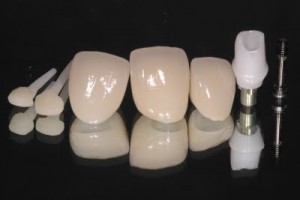Dental crowns are effective in enhancing your smile by simultaneously modifying the color, position and size of your teeth. Dental crowns are essential in the overall cosmetic treatment of your teeth and/or strengthening the structure of weakened teeth. A properly made dental crown enhances the natural beauty of your teeth, enhances the integrity of your structure and improves the quality of your smile.
What is the procedure?
Making a dental crown involves 3 main steps:
(1) Professional formation of weakened tooth structures,
(2) making crowns in a dental laboratory, and
(3) installation of a dental crown to strengthen weakened teeth.
Traditional dental crowns are made of metal or porcelain. Conventional tooth-colored porcelain is physically similar to our household porcelain – it is inherently brittle. Metal dental crowns, on the other hand, are strong but less beautiful and natural in terms of aesthetics. Although porcelain veneers are commonly used in cosmetic dentistry, they do not provide structural reinforcement to the tooth and their durability is questionable when used on structurally compromised teeth. A skilled and experienced dental technician is also essential for the creation of a well-fitting traditional crown with excellent artistic quality.
Evolutionary R material
Some zirconium materials have been used for the manufacture of artificial diamonds (cubic zirconia) and artificial hip joints for a long time. One of the advantages is its compatibility with the living body – the human body integrates well with zirconium materials with very minimal incompatibility reactions.
Studies have shown that the strength of zirconium dental material is now comparable to titanium, a metal commonly used for aircraft structures and dental implants. The latest development of CAD-CAM-based zirconium dental crowns combines the precision of computer technology and the strength of metal crowns while also offering superior aesthetic qualities. Without relying on a dental technician, a custom-fit crown can also be machined using CAD-CAM technology, significantly reducing human intervention. Studies have shown that the fit of CAD-CAM crowns is excellent down to the sub-microscopic level.
Excessive tooth structure removal can compromise the long-term functional outcome of the tooth. Excessive tooth structure removal is no longer necessary because very thin crowns can be made due to the physical strength of zirconium crowns.
As a result, zirconium dental crowns excel in both structural strength and aesthetic qualities. It may be a near-perfect material for cosmetic dental care. Perhaps we are finally realizing the full potential and meaning of “Diamonds are a girl’s (and man’s) best friend.”
For more information please click here






